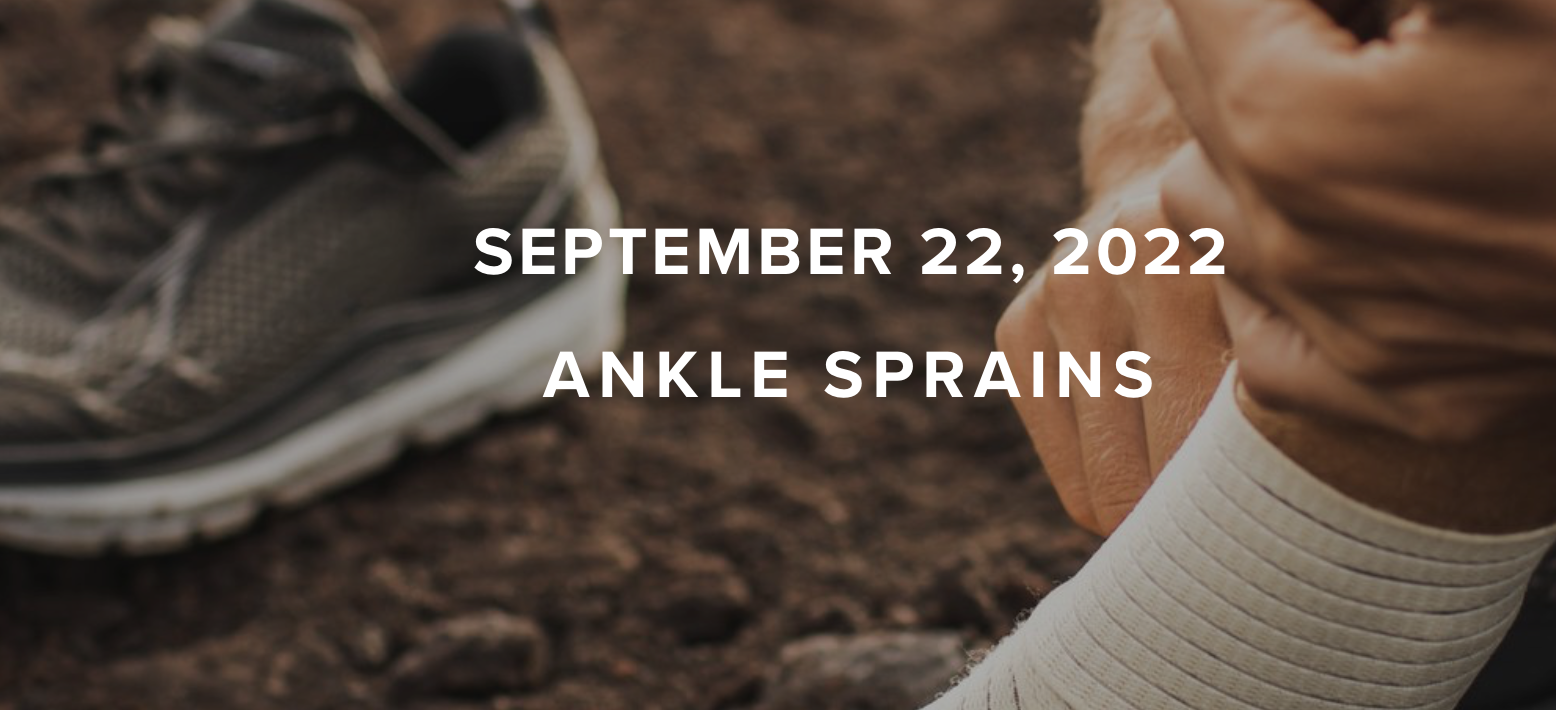The Ankle
The ankle joint is formed where the foot and the leg meet. The ankle, or talocrural joint, is a synovial hinge joint that connects the ends of the tibia and fibula (shin bones) in the lower limb with the proximal end of the talus bone in the foot. The joint between the tibia and the talus bears the vast majority of the body's weight while the fibula keeps the talus under the tibia.
The term "ankle" is used to describe structures in the region of the ankle joint proper. The joint under the ankle allows side to side movement while the ankle joint proper allows the foot to hinge up and down. Together they allow the foot to move as it were connected to the leg with a ball joint. Listed below are some of the most common pathologies written by our staff and local physicians that we see.
Common Ankle Injuries
Ankle Sprain
Occurs when the ligaments that support the ankle joint are stretched or torn. It usually happens due to a sudden twist, roll, or turn of the ankle, causing pain, swelling, and difficulty walking.
Ankle Fracture
Refers to a break or crack in one or more of the bones that make up the ankle joint. Fractures can occur in the tibia (shinbone), fibula (smaller bone on the outside of the lower leg), or talus (the bone connecting the leg to the foot). Fractures often cause severe pain, swelling, and an inability to bear weight.
Achilles Tendonitis
Inflammation of the Achilles tendon, which connects the calf muscles to the heel bone. It typically occurs due to overuse, repetitive stress, or poor footwear. Symptoms include pain, swelling, and stiffness in the back of the ankle.
Achilles Tendon Rupture
Occurs as a result of a sudden forceful trauma of the calf muscles or from repetitive stress over time. It causes a sudden, sharp pain in the back of the ankle, difficulty walking, and a noticeable gap or indentation above the heel.
High Ankle Sprain
Also known as a syndesmotic sprain, involves injury to the ligaments connecting the tibia and fibula bones above the ankle joint. It typically occurs due to excessive external rotation or forceful twisting of the ankle. High ankle sprains often cause pain, swelling, and instability in the upper ankle area.
Ankle Impingement
When soft tissues or bone structures within the ankle joint get pinched or compressed during movement. It can result from repetitive trauma, previous injuries, or anatomical variations. Symptoms include pain, limited range of motion, and a feeling of catching or locking in the ankle.
Osteochondral Lesion
A defect or injury to the cartilage and underlying bone within the ankle joint. It can occur due to trauma, repetitive stress, or as a result of an ankle sprain. Symptoms include pain, swelling, joint stiffness, and instability.
Ankle Bursitis
Inflammation of the small fluid-filled sacs called bursae, which cushion and reduce friction between tendons, ligaments, and bones. Ankle bursitis often occurs due to repetitive motions, excessive pressure, or direct trauma to the bursae around the ankle, leading to pain, swelling, and warmth in the affected area.
Foot & Ankle WEBINARS
Foot & ankle BLOGS
Achilles Tendonitis
Achilles Tendonitis is an inflammation of the thin sheath-like structure around the achilles tendon. This tendon attaches to the back of our heel and allows the muscles in the calf move our foot down so that the toes can point towards the ground (plantar flexion). The Achilles Tendon is a long and thick tendon, which moves our foot down, so that the toes point to the ground (plantarflexion). The pain can be shooting, piercing, and burning pain. The first few steps in the morning many times are the worst. It is important to treat this condition as soon as possible as it may progress to the point where it causes permanent damage to the achilles tendon proper. Ruptures and the need for surgical repair may be avoided by early diagnosis and treatment of this very common condition.
Possible Factors:
1. Overuse, such as too much running, especially up or down hill.
2. Trauma, such as a kick to the tendon.
3. Shoe or boot (ski/snowboard) pressure, especially at its attachment to the heel, or just above it.
Treatments:
a. Ice, Anti-inflammatories, rest,
b. Heel lifts
c. Removable Cast Boot or CAM Walker
d. Achilles Heel Guard
e. Custom Orthotics
Authors:
Washington Foot & Ankle
Peter Vincent, DPM
Lake Washington Physical Therapy
Benjamin Wobker, PT, MSPT, DPT
Foot Arthritis
Ankle Sprain
A common musculoskeletal injury in which the ligaments of the ankle are stretched, partially torn, or completely torn due to sudden over stretching. This most often occurs when the ankle is suddenly "twisted" in a sports activity or by stepping off an uneven surface. Most ankle sprains involve the ligaments on teh outside of the ankle as the foot folds underneath the body. This is referred to as an inversion mechanism. Ankle sprains are very common in sports involving rapid side to side movemnts ("cutting"), such as basketball, soccer, and tennis.
Sprains are graded based on the extent of the damage to the ligament.
Grade 1 Sprain: An injury without macroscopic tears. No mechanical instability is noted. Pain and tenderness is minimal.
Grade 2 Sprain: A partial tear. Moderate pain and tenderness is present. Mild to moderate joint instability may be present.
Grade 3 Sprain: A complete tear. Severe pain and tenderness, inability to bear weight, and significant joint instability are noted.
Treatment:
R.I.C.E – Rest, Ice, Compression, Elevation. The best first step to this injury before you can see a doctor of physical therapist. Depending on the severity of the sprain, you might or might not even be able to walk without pain, so the best thing to do is stay off of the injury as much as possible, and see a doctor as immediately for evaluation.
Once in physical therapy, common first stages of treatment are to restore your basic range of motion and reduce swelling, begin a strengthening regimen, normalize gait (walking pattern), and then begin a return to normal activities. Only after success in all these stages are patients ready to begin agility and plyometric exercises and activities that begin to mimic game and competition.
Shin Splints
This term applies to pain in the front of the leg, occurring anywhere between the ankle and the knee, usually with prolonged walking or running. In extreme cases one can have pain in this area with just standing.
Symptoms:
Shin splints usually begin as a dull aching pain in thefront of the lower leg after prolonged walking, running, or jumping. If left untreated, the pain becomes sharp and intense with all weight-bearing activities. Other serious problems of the lower leg, such as stress fractures, are usually painful even while resting.
Causes:
The muscle in the front of the leg which usually becomes painful is the Anterior Tibial Muscle, which is encased in a thin sheath. This muscle attaches to the foot; and as long as the foot is properly aligned, the muscle functions efficiently and painfree. However, when the foot is pronated (the foot rolls outward and you walk more on its inner aspect), the Anterior Tibial Muscle twists within its sheath. This twisting of the muscle within its sheath can cause tiny tears in the muscle, or the muscle rubs abnormally against its sheath, and produces inflammation and pain.
Pain relievers &
Treatment:
"The best treatment is prevention or early intervention." This is best accomplished by orthotics. Custom-made orthotics will realign your feet, correcting pronation; and they will provide you with the shock-absorbency needed to cure and prevent shin splints from occurring. If you have tried other methods of treatment, and they have failed, custom-made orthotics are the answer to your problem. It is no coincidence that serious amateur athletes, as well as most professional athletes, wear custom-made orthotics to keep them painfree and "in the game."
AUTHORS & CONTRIBUTORS
BENJAMIN WOBKER, PT, MSTP, CSCS
HORK DO, PT, DPT
MARK BOUMA, PT, DPT, OCS, COMT, FAAOMPT, CFI
KATIE HUTCHINS, PT, DPT
MANDIE MAJERUS, PT, MSPT, OCS, CSCS, SFMAC, CMPT, CFSC
BOB ADAMS, DO, USATF TEAM PHYSICIAN 1984-2015
GHISLAINE ROBERT, MD
JONATHAN HALL, MD
LAWRENCE MAURER, DPM
PETER VICENT, DPM
Disclaimer:
This website is an information and education resource for health professionals and individuals with injuries. It is not intended to be a service for patients and should not be regarded as a source of medical or diagnostic determination, or used as a substitute for professional medical instruction or advice. Not all conditions and treatment modalities are described on this website. Any liability (in negligence or otherwise) arising from any third party acting, or refraining from acting, on any information contained on this website is hereby excluded.














